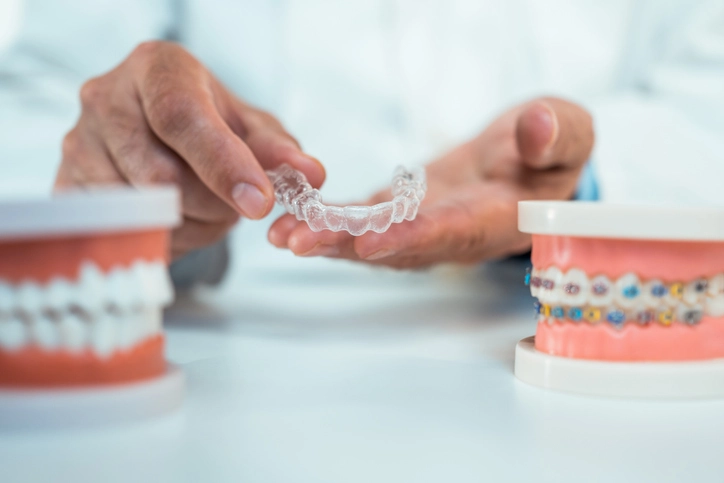Invisalign vs. Traditional Braces: Pros and Cons
Invisalign® vs. Traditional Braces: Pros and Cons
Committing to orthodontic treatment can be exciting. After all, you’re getting to enhance your smile, and with it, your confidence. However, choosing the right orthodontic treatment might also feel overwhelming. Deciding between Invisalign® vs. traditional braces comes with lots of considerations, and you might not even know where to start. Fortunately, our dental professionals are here to help and make your choice a bit easier. Here’s what you need to know about the pros and cons of each option.

The Pros and Cons of Invisalign®
Invisalign® is a modern orthodontic treatment that many teens and adults gravitate to. The treatment consists of a series of clear, removable aligners that gradually move your teeth into the correct position. They’re discreet and few people will even notice you’re wearing them!
Advantages of Invisalign
Invisalign® hasn’t gained so much popularity for no reason. Keep these advantages in mind as you weigh your options:
- Nearly Invisible—As the name suggests, these clear aligners are virtually undetectable when worn. Many adults and teenagers prefer the ability to maintain their appearance during treatment.
- Removability—Unlike braces, you can remove your aligners for eating, drinking, brushing, and flossing. This flexibility makes maintaining oral hygiene much easier and allows you to enjoy your favorite foods without restrictions.
- Comfort—In the past, braces have gotten a reputation for discomfort. Invisalign® comes with a very low risk of cuts or irritation, and most patients experience less discomfort overall.
- Predictable Results—Today’s advanced 3D imaging tools allow you to see what your results will look like before treatment ever begins.
Disadvantages of Invisalign
Despite the pros, Invisalign® isn’t a perfect treatment. Be sure to consider these potential disadvantages, too:
- Higher Cost—Invisalign® sometimes costs more than traditional braces. However, this will depend on the complexity of your case.
- Discipline—A successful Invisalign® treatment requires plenty of discipline. You’ll need to remember to wear them for at least 20 hours per day.
- Less Effective for Complex Cases—Invisalign® isn’t always effective for complex issues like severe bite issues, significant rotations, and major tooth movements.
What to Expect From Traditional Braces
When most people think of orthodontics, traditional braces are likely the first thing that comes to mind. Braces achieve the same goal as Invisalign® but instead consist of metal brackets bonded to each tooth. They’re adjusted over time to gently move teeth into proper alignment.
Advantages of Traditional Braces
Braces have stood the test of time, and it’s easy to understand why. Here are just a few advantages of this customizable treatment approach:
- Cost Effectiveness—Compared to Invisalign®, braces tend to be a bit less expensive. They’re often more accessible for families with multiple children.
- Versatility—Metal braces can address a wide range of orthodontic issues, including severe crowding and complex bite problems.
- Easy Compliance—Since braces are fixed to your teeth, there’s no risk of forgetting to wear them or losing them.
- Faster Results—Are traditional braces faster than Invisalign®? Sometimes! For certain types of tooth movements, braces work quicker than clear aligners.
Disadvantages of Traditional Braces
Of course, traditional braces also have drawbacks. Consider the following as you make your decision:
- Visibility—Metal brackets and wires are clearly visible. This visibility can hamper confidence for some, especially adult patients in professional settings.
- Dietary Restrictions—You’re discouraged from eating hard, sticky, and chewy foods for the duration of the treatment.
- Oral Hygiene Challenges—Brushing and flossing around brackets and wires requires more time and effort. Food particles can easily get trapped, putting you at a higher risk of gum disease.
- Irritation—Some patients struggle with mild discomfort or irritation from the metal, especially after adjustments.
Which Is Better, Invisalign® or Braces?
Now that you know the pros and cons of each orthodontic option, you can better decide which is best for you. Both approaches are excellent ways to straighten the teeth, but many patients do better with one over the other. Here’s what your dentist will take into account:
- Age and Lifestyle—Adult professionals may prefer Invisalign’s discretion, while teenagers might benefit from the “set it and forget it” nature of traditional braces. Be sure to let your dentist know about your daily routines that could impact treatment.
- Complexity—How complex is your dental issue? Minor or moderate alignment problems often respond well to Invisalign®, but complex cases might require the precision of metal braces.
- Budget—Before committing to treatment, ask for a cost estimate. Look at your dental insurance plan to figure out if you’re covered for orthodontic care.
- Personal Discipline—Be honest with yourself. Will you be able to wear aligners for 20 to 22 hours every day? If you’re forgetful or frequently eat snacks throughout the day, traditional braces might be better.
Helping You Straighten Up Your Smile
We all want a straight, aligned smile, and Brookwood Dental Center is here to help you achieve it. With years of experience in orthodontic care, our Fenton, MO team will evaluate your situation and recommend a treatment plan that makes sense for you. Contact us today to schedule a consultation at our office.
FAQs About Invisalign® and Braces
How long does each treatment take?
Traditional braces typically require 18-36 months, while Invisalign® averages 12-24 months. Keep in mind these are general windows, and your treatment might take longer if you have a more complex case.
Can I eat normally with both treatments?
Invisalign® allows you to eat normally, since you can simply remove your aligners during meals. However, braces require avoiding hard or sticky foods that could damage the metal brackets.
How often do I need orthodontist appointments?
Traditional braces require adjustments every 4-6 weeks, while Invisalign patients typically visit every 6-10 weeks for progress checks and new aligners. Your dentist will come up with a more specific timeframe based on your needs.
